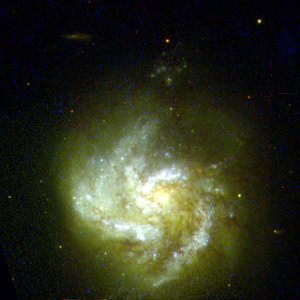NGC 2415
| Galaxy NGC 2415 |
|
|---|---|

|
|
| Photo from the Hubble Space Telescope | |
| AladinLite | |
| Constellation | Twins |
|
Position equinox : J2000.0 , epoch : J2000.0 |
|
| Right ascension | 07 h 36 m 56.7 s |
| declination | + 35 ° 14 ′ 31 ″ |
| Appearance | |
| Morphological type | in the |
| Brightness (visual) | 12.2 mag |
| Brightness (B-band) | 12.8 mag |
| Angular expansion | 0.9 ′ × 0.9 ′ |
| Surface brightness | 11.8 mag / arcmin² |
| Physical data | |
| Affiliation | LGG 148 |
| Redshift | 0.012622 ± 0.000017 |
| Radial velocity | 3784 ± 5 km / s |
|
Stroke distance v rad / H 0 |
(168 ± 12) · 10 6 ly (51.6 ± 3.6) Mpc |
| diameter | 45,000 ly |
| history | |
| discovery | Wilhelm Herschel |
| Discovery date | March 10, 1790 |
| Catalog names | |
| NGC 2415 • UGC 3930 • PGC 21399 • CGCG 177-038 • MCG + 06-17-021 • IRAS 7336 + 3521 • 2MASX J07365672 + 3514310 • GC 1546 • H II 821 • h 456 • GALEX ASC J073656.68 + 351432.9 • HARO 1 | |
NGC 2415 is an irregular galaxy of Hubble type in the constellation Gemini on the ecliptic . It is around 168 million light years away from the Milky Way and is around 45,000 light years in diameter .
The supernovae SN 1998Y (Type II) and SN 2000C (Type Ic) were observed here.
The object was discovered on March 10, 1790 by the astronomer William Herschel with a 48 cm telescope.
Web links
Commons : NGC 2415 - collection of images, videos, and audio files
